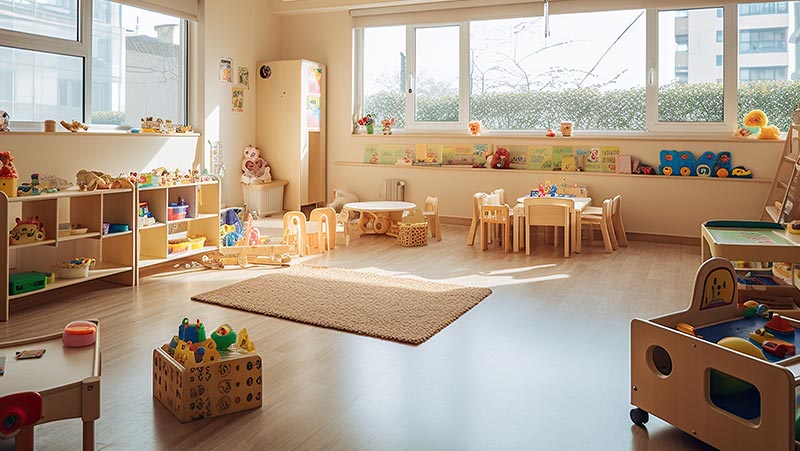
By Jeff Andrews, President
Business of Child Care
One of our clients has been running an in-home family child care business for nearly 20 years. With all the challenges Sally faces as a small business owner, filling up child care slots is not one of them. Sally is only half-joking when she tells her families she should be one of the first people they inform about a new pregnancy, so she can plan to have space available.
For too long, child care access in the U.S. has been left for parents to figure out on their own. The true cost of this ad hoc strategy is coming to light in recent studies that show the lack of adequate child care is costing the U.S. economy more than $120 billion a year. Things will not get better on their own. Between December 2019 and March 2021, this country saw some 16,000 child care programs close. The pandemic certainly contributed to that, but other business and economic realities are exacerbating an ongoing shortage.
As employers struggle to attract and retain workers, more of them are stepping up to fund and build their own child care centers. It’s a positive trend, but it involves an investment and expertise beyond the reach of most employers, and it is not an option for most workers.
Civic leaders who understand the lack of quality child care is hindering economic growth in their region are sounding the alarm. There is no one size fits all solution – and in most cases, it will take a multi-pronged approach involving communities and government to start making inroads to begin to ease this crisis.
Business of Child Care works with regional stakeholders, including business and civic leaders, to address child care shortages, primarily in rural communities, where nearly 60% of the population resides in child care deserts. One key to our efforts is offering resources to support and grow existing child care businesses. That only gets you so far.
Most of the communities we work with still need to find additional space for child care, which can come in several ways. The first is new in-home family child care capacity. However, that is increasingly difficult as home ownership becomes more out of reach for younger people. According to the U.S. Census Bureau, homeownership for young adults in the U.S. declined nearly ten percent between 2003, before the Great Recession, to 2015, following the recovery.
In addition to challenges in home ownership, communities may have laws prohibiting child care businesses in residential areas, or landlords who don’t allow it for those renting their homes. Even if these challenges didn’t exist, this option often isn’t scalable. The greatest need in most communities is for more infant/toddler spaces, but each new family child care business can often only serve up to three children in this age group. You could not find enough individual homes to meet the needs of most areas.
Communities can also look to repurposing existing buildings to house new child care spaces, or with new construction to increase capacity. Increasingly, communities are considering new ways to support child care with space. We believe there is a future with a multi-unit building approach that can offer efficiency and flexibility a single child care center cannot, while also better matching the needs of the local community.
Imagine a single building with multiple units that could house several individual child care businesses, each offering different options for families. Perhaps one that operates during traditional hours, one that caters to 2nd or 3rd shift workers, one that specializes in infants and toddlers, is culturally specific, or one that works with children who have special needs. In contrast, a single, large child care center generally operates one program, with one set of hours. However, communities are not homogenous, and neither are the needs of their families.
Across the country, communities are starting to consider this type of multi-unit solution, which allows stakeholders to have to some control over the type and quality of child care businesses that would be supported in such a facility. This solution can be particularly attractive in rural areas that often can’t support larger child care centers. There generally aren’t enough children or staff to make the finances work for a large child care center. Several smaller spaces that are independently licensed and operated could more easily prosper and provide a similar number of licensed child care slots, even if all those child care spaces exist under one roof.
Smaller businesses also mean you have an owner/operator for each of those businesses, rather than one owner and staff that can be hard to come by these days. By lifting up individual owners, a community is building on its own economic vitality, and the small business owners then have a saleable asset that provides continuity of care for families if the owner decides to do something else.
A multi-unit building also gives individual owners an opportunity to open their business without having to source a location and pay for infrastructure costs on their own or commit to turning their own home into a space for their child care business. This means more opportunities for entrepreneurs without deep pockets to realize their dream of owning a small business.
Putting several, smaller child care businesses under one roof brings additional efficiencies into play. While each business is fully self-contained with its own restrooms and warming kitchen, businesses can share single, on-site indoor and outdoor play areas as well as vendors and services for food, cleaning, and supplies. Through proximity, owners and staff would have access to other child care professionals, which can be important for career development and observing best practices.
Finally, because these multi-unit buildings would be owned by a non-profit, community or municipal entity, the building’s use for child care businesses could be assured – there is no profit motive to turn the building over for some other use, which could happen with a single, large child care facility.
At Business of Child Care, we are helping to meet the need for child care accessibility by working with communities that are exploring how they might repurpose existing buildings for child care, as well as communities that are breaking ground on entirely new buildings. Our EarlyEd FlexPlex provides one model for a multi-unit child care building.
There are, of course, challenges communities must navigate, not the least of which is funding. However, a primary hurdle remains how child care businesses are regulated. Many projects can’t even get off the drawing board due to state laws and licensing requirements that were enacted during a time when the only models were in-home family child care and traditional child care centers. Many states are beginning to evaluate opportunities to update licensing approaches, and some are even beginning to act. The process is not an easy one, but when it succeeds, it will expand opportunities for communities to create child care outcomes that meet local needs without sacrificing best practices for health and safety of children.
Clearly the models we have now are not working. More than half the people in the U.S. live in communities that are underserved for child care. Fixing that will require communities and governments to step up on multiple fronts, including reworking outdated policies, and re-thinking how best to support families in our ever-changing world.
Many communities find the process complicated and overwhelming, which is where a third party with the right expertise can greatly reduce the timeline to address an issue that is already critical for too many communities. Adequate child care is no longer a “nice to have” – beyond the obvious benefit for the child, it is necessary for the economic well-being of communities that depend on a labor force that includes parents.
Learn more about how Business of Child Care is working to help communities meet their child care goals at www.businessofchildcare.com.

